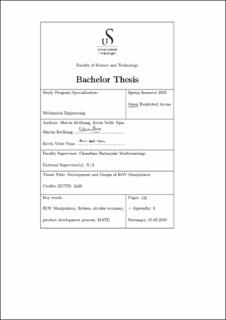| dc.description.abstract | The thesis is carried out in collaboration with the student organization UiS Subsea. The
primary objective of this thesis is to design and develop a manipulator for the ROV,
named YME, using the product development process (PDP). The end goal is to showcase
the final product at the MATE ROV Competition 2023. The importance of sustainability
has been highlighted in recent years, and this year, MATE ROV Competition focuses on
the United Nations Decade of Ocean Science for Sustainable development (2021-2030),
and challenge students to contribute to UNs Sustainability goals by seeking sustainable
solutions for their projects.
The product development process consisted of four phases: planning, concept development, concept generation, and product concept selection. The planning process focused
on resource allocation, declaring a mission statement, and establishing a good foundation for the process ahead. Gathering benchmarking information and establishing target
specifications was a crucial part of the concept development phase, prior to the concept
generation process, as the information and specifications served as a guidance and outline for the concepts to be generated. By a circular economy approach, the reuse of old
components within UiS Subsea was evaluated, and potential components were located.
The circular economy approach influenced design decisions, and resulted in cost and timeefficiency, and contribution towards sustainability in engineering practices. Concepts were
generated for both the manipulator arm and end-effector, and the most promising ones
were selected for further development. Eventually one concept for the arm, and one for
the end-effector, was selected and further developed through detailed design.
Through detailed design, a complete CAD model of the manipulator was made, also
material was selected and necessary calculations were performed. The outcome was a
three degree of freedom manipulator arm with a rotating end-effector, pitch function,
and a telescope function. Through prototyping and extensive testing, the design was
evaluated and deemed sufficient according to customer needs and target specifications.
The outcome of the project was a fully functional ROV Manipulator able to perform all
the required MATE tasks, and contributed greatly towards the successful qualification to
the 2023 MATE ROV Competition. However, there was room for further improvement
and optimization of both the manipulator and the process, and hopefully the manipulator
can serve as a foundation for future UiS Subsea manipulator projects. | |
